Abstract
The noise pollution issue along elevated urban rail transit lines has attracted considerable attention; however, research on the sound insulation characteristics of buildings during operational train noise remains limited. In this study, a field testing campaign was conducted in a building featuring facades constructed from aerated concrete blocks embedded with single-layer glass sliding windows along an elevated rail transit line. The sound insulation characteristics of the building were obtained based on measured data. By neglecting the influence of lateral sound transmission, a window-wall assembly model was proposed for simulating the building’s sound insulation capability. To ensure the accuracy of the prediction results, initial simulations were first performed on individual elements and compared against the experimental sound insulation curves to identify key parameters. Subsequently, simulations of the window-wall assembly model were carried out and compared with test data to determine the acoustic boundary treatment. The results showed that the amount of sound insulation measured in the buildings ranged from 11.16 dB (A) to 19.85 dB (A) during train passage, exhibiting a notable dip in sound insulation within the frequency range of 80 Hz to 100 Hz. Conversely, the predicted sound insulation of 26.38 dB was much higher, also showing a significant dip at around 100 Hz. The simulated values aligned closely with the measured values below 500 Hz; however, discrepancies were observed in mid-to-high frequency ranges above this threshold. To this end, further simulations were performed on a window-wall assembly model incorporating air gaps to take into account air leakage effects. The results indicated that the presence of air gaps considerably diminished high-frequency sound insulation; when accounting for window air leakage effects, the simulated results approached closer alignment with the measured ones.
1. Introduction
By the end of 2023, a total of 59 cities in China had operational urban rail transit lines, boasting an aggregate operating mileage exceeding 11,000 km []. While urban rail transit significantly enhances travel convenience for the public, it also generates notable environmental noise and vibration issues. These problems are particularly pronounced for elevated lines situated near residential areas, where frequent noise and vibration complaints have become a major concern [,,,,,,,].
1.1. Sources and Characteristics of Noise from Elevated Urban Rail Lines
The noise generated by elevated urban rail lines during the operation period can be classified into several categories according to the noise source [,], including wheel-rail noise, aerodynamic noise, traction system noise, and structural secondary noise. Wheel-rail noise refers to the noise generated by the contact between the wheels of the train and the tracks during the train’s movement, which mainly includes rolling noise, impact noise, and curve whistle noise, of which rolling noise accounts for the largest proportion; aerodynamic noise is the noise generated by the train’s high-speed operation when interacting with the air; traction system noise refers to the noise generated by the train’s power source and cooling module during normal operation; structural secondary noise refers to the noise generated by the vibration of the elevated bridge and the surrounding structures of the platform when the train passes by.
In addition to the classification based on the noise source, the elevated line train noise can be classified into airborne noise and structural secondary sound according to the way it is transmitted into the building interior []. Airborne noise is emitted by the source and then transmitted through the air and the building’s sound insulation to the indoor environment, while secondary structural noise is generated by the building’s own vibration. Both of them interact with each other and jointly affect the sound environment quality in the building.
1.2. Research Progress on Sound Insulation of Buildings
Current research on noise and vibration along elevated urban rail transit lines mainly focuses on noise characteristics and sound field distribution laws [,], as well as comprehensive noise and vibration reduction measures (including structural acoustic optimization [,], track damping [,], sound barriers [,] or sound barriers on the trackside []), with little attention paid to the sound insulation performance of buildings. In fact, the airborne noise emitted by the elevated urban rail transit line can be transmitted through the building’s exterior walls to the interior, and the exterior walls can effectively reduce airborne noise and serve as sound barriers. In recent years, considerable research has been conducted on enhancing sound insulation performance within the area of building acoustics:
(1) Sound insulation performance of individual building components, using either the finite element method or laboratory testing of specific wall structures and window assemblies [,,,,]. For example, Granzotto et al. [] systematically studied the influence of glass frame, glass thickness, and the presence of PVB on the sound insulation performance of windows using the sound laboratory testing protocol; Wu et al. [] studied the sound insulation characteristics of several lightweight partition walls by employing both laboratory testing and finite element methods; Zhu et al. [] investigated the influence of glass thickness and air layer thickness on the sound insulation performance of double-glazed windows using COMSOL finite element software. Liu et al. [] tested the sound insulation performance and mechanical properties of medium density fiberboard (MDF) and rubber multilayer panels. The weighted sound reduction was 28.0 dB for 6 mm MDF, while it was 37.4 dB for 6 mm wood composite damping material, an increase of 25.1%. Wang et al. [] investigated the influence factors on the impact sound insulation performance of floor lining type, thickness, mass density and dynamic stiffness of elastic material, and the quality and thickness of floating plates.
(2) Sound insulation performance of composite components, with particular focus on the sound insulation capabilities of composite wall structures and composite window structures [,,,,,,]. These studies are crucial for improving acoustic comfort in various environments like residential buildings, commercial spaces, and industrial facilities. For instance, Liu [] explored the sound insulation performance of composite panel walls by employing finite element simulation techniques. This approach allowed for a detailed analysis of how different materials and structural configurations influence sound transmission loss. Zhao [] proposed a theoretical calculation formula that quantifies the sound insulation properties of these composite systems. His research emphasizes the importance of understanding material properties such as density, thickness, and damping characteristics in predicting overall acoustic performance. Furthermore, ongoing studies are exploring innovative materials and design strategies aimed at enhancing sound isolation while maintaining other essential building attributes like thermal efficiency and structural integrity.
In general, current research on the sound insulation performance of buildings primarily focuses on the sound insulation characteristics of individual or composite components. However, there remains a scarcity of studies addressing the sound insulation performance of actual buildings, particularly those involving field measurements. Furthermore, existing experiments at the component level have predominantly utilized idealized artificial sound sources (such as white noise). This leads to an equal sound intensity source for all concerned frequencies. However, it has been demonstrated that the sound insulation performance of buildings is closely related to the characteristics of operational sound sources, which means that using idealized artificial sound sources may not reflect the real sound insulation characteristics of buildings. Hence, it is crucial to consider this effect under actual conditions.
1.3. Structure of This Paper
This study conducted noise field tests in both indoor and outdoor areas of buildings situated near an elevated urban rail line to obtain the sound insulation properties. Utilizing the measured data, a window-wall assembly model was proposed to simulate and analyze sound insulation performance. The findings from this research can give insights for implementing effective noise control measures in buildings located along elevated urban rail lines.
The remainder of this paper is structured as follows. Section 2 describes the test site, test setup and results of the field measurement. A numerical window-wall assembly model is proposed to simulate the acoustic insulation performance in Section 3. Section 4 further discusses the impact of windows and walls on the building’s sound insulation performance. The main conclusions and future work are presented in the closing section.
2. Field Measurement
2.1. Description of Test Site
A test campaign was conducted on an elevated urban rail transit line in Wuhan, China. The bridge employs a single-box, single-chamber concrete box girder with a span of 25 m and a bridge pier height of H = 12 m. The subway train was grouped using four B-type vehicles with an operating speed of 50 km/h. The test building was a 23-storey frame-shear wall structure with a total height of h = 70. The horizontal distance between the building and the elevated line was L = 25 m.
2.2. Test Setup
The sensors employed are Brüel & Kjær microphones from Denmark, paired with a DH9581 dynamic data collector. In addition to the collector and microphones, the setup includes the necessary adapters, external data transmission cables, and sensor brackets. Sound measurement locations have been strategically established both indoors and outdoors on the fifth floor of the structure. According to Chinese Guidelines (GB/T 19889.5-2006 Acoustics—Measurement of sound insulation in building elements—Part 5: Field measurements of airborne sound insulation of façade elements and facades) [], indoor and outdoor microphone measurement points are positioned 1.5 m from the wall and at an elevation of 1.2 m above ground level. The sampling frequency of the microphones is set as 10,000 Hz. The configuration of these measurement points is illustrated in Figure 1. The exterior wall of the test room comprises aerated concrete blocks with embedded single-glazed sliding windows. Detailed parameters regarding the building facade and windows are presented in Table 1.
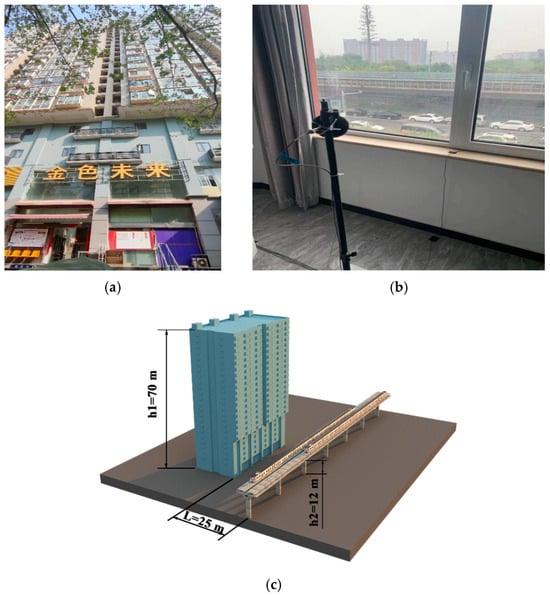
Figure 1.
Test setup: (a) real picture of the test building; (b) arrangement of microphone indoor (c) side view.

Table 1.
Parameters of building facade and windows.
2.3. Test Results
Long-term continuous monitoring was conducted to capture the complete process of sound pressure variation during train passage. The representative time series of sound pressure recorded by indoor and outdoor microphones during the train passage are shown in Figure 2.
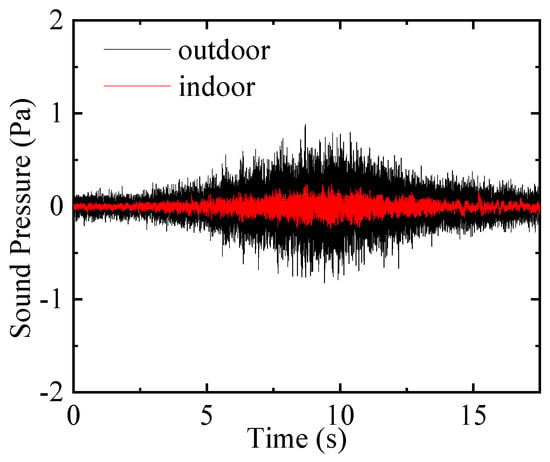
Figure 2.
Time series of indoor and outdoor sound pressure under train passage.
As the train passes, there is a significant increase in sound pressure, and a distinct spindle-shaped waveform can be observed in the time history curve, with outdoor sound pressure notably exceeding indoor sound pressure. The sound pressure time history is further analyzed in the 1/3 octave frequency band and processed using the A-weighted network. In accordance with the testing specifications, the analysis frequency band covers 18 center frequencies ranging from 100 Hz to 5000 Hz []. Figure 3 illustrates the sound pressure levels in the one-third octave frequency band for both outdoor and indoor test points of the building during multiple train passages (exceeding 20 trains). The test results are presented as envelope curves, along with their corresponding mean values.
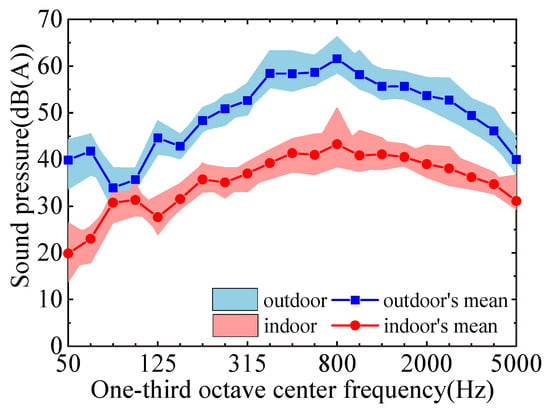
Figure 3.
Indoor and outdoor A-weighted sound pressure level.
Utilizing the measured average sound pressure level curves for both indoor and outdoor environments, the difference between these two can be calculated to determine the sound insulation (or sound transmission loss) of the building, as illustrated in Figure 4. Analysis of the sound insulation curve reveals that the sound insulation of the building is not uniformly distributed across the frequency spectrum. The sound insulation ranges from 3 to 22 dB for frequencies from 50 Hz to 5000 Hz, exhibiting a peak in the low-frequency band below 60 Hz, with minimal sound insulation capacity observed between 80 Hz and 100 Hz. In contrast, there is a gradual increase in sound insulation capacity from 125 Hz to 800 Hz, followed by a gradual decrease from 1000 Hz to 5000 Hz.
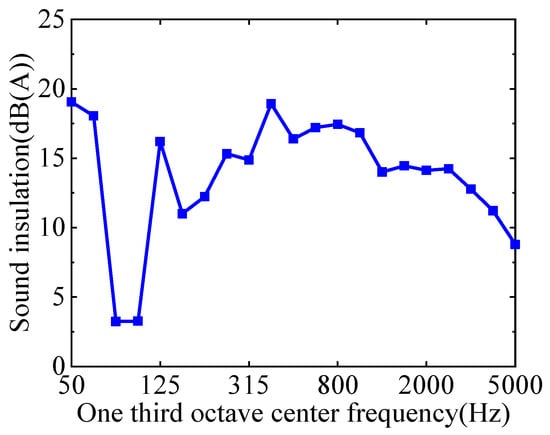
Figure 4.
Sound insulation curves for window-wall combination components.
Further calculations were conducted to determine the overall sound insulation R value of the building. The sound insulation values corresponding to all train pass-by events are presented in Figure 5. The measured sound insulation range for the test building is between 11.16 dB (A) and 19.85 dB (A), with an average value of 16.4 dB (A).
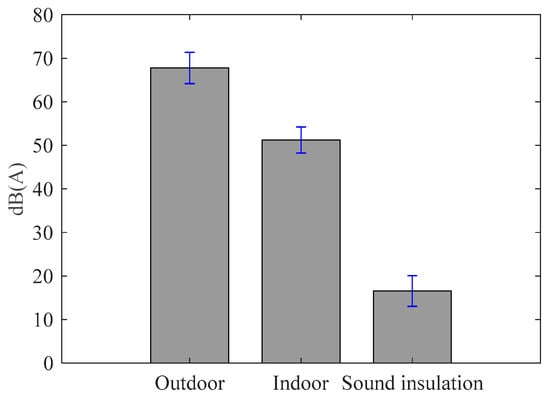
Figure 5.
Sound insulation for window-wall assembly component.
3. Numerical Simulation of Acoustic Insulation Performance Based on the Window-Wall Assembly Model
In this section, a numerical model is presented to give an alternative tool to predict the acoustic insulation performance of buildings along elevated urban rail transit.
3.1. Principles and Assumptions of the Numerical Model
The simplified numerical model is established based on the following assumptions:
(1) The low-frequency secondary structure-borne noise is not considered. The noise generated by a train passing buildings along the railway line encompasses not only wheel-rail noise, aerodynamic noise, and other airborne radiated sounds, but also induces vibrations in the building structure that result in low-frequency secondary structure-borne noise. Given that the frequency range of secondary structural noise is relatively narrow (20 Hz to 200 Hz), this study disregards its influence and focuses solely on the sound insulation performance of buildings against airborne radiated noise.
(2) Only the direct sound transmission of the building facade is considered and the lateral sound transmission loss from adjacent walls is ignored. Figure 6 illustrates a schematic view of the transmission paths for outdoor noise entering indoor spaces. Dd denotes the direct sound transmission path, while Ff and Df indicate lateral sound transmission paths. In comparison to lateral sound transmission, direct sound transmission predominates; thus, the acoustic insulation performance of the exterior wall directly affects the overall sound insulation performance of the building.
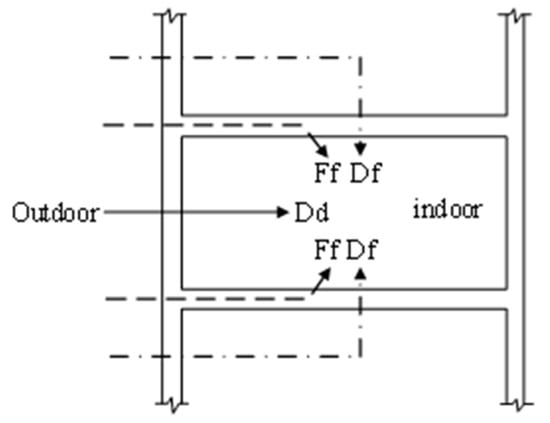
Figure 6.
Sound transmission pathways.
In light of these facts, the influence of the lateral sound transmission effects of the building is ignored, and a finite element model of the exterior wall (window-wall assembly components) has been developed. Simulations have been performed to evaluate the acoustic insulation performance of the building.
To ensure the accuracy of the simulation results, initial simulations were first performed on individual elements (wall and window) and compared against the experimental sound insulation curves to identify key parameters. Based on this, a window-wall assembly model is further established. Subsequently, simulations for the window-wall assembly model were carried out and compared with test data to determine the acoustic boundary treatment. The main idea of the simulation flowchart is illustrated in Figure 7.
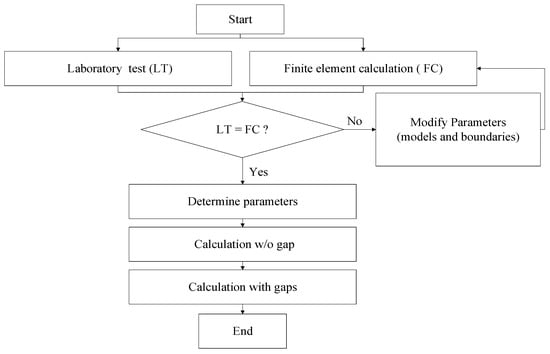
Figure 7.
Procedures of the proposed method.
The finite element acoustic calculations are conducted using the LMS Virtual.Lab platform. The acoustic module within the LMS Virtual.Lab software is a specialized CAE tool designed for finite element analysis in the field of acoustics, incorporating methods such as FEM and BEM, among other acoustic analysis techniques.
3.2. Parameters for Acoustic Calculations
According to the laboratory sound insulation test specifications for individual elements [], the planar dimensions of the window component are 1500 mm × 1250 mm or proportionally enlarged according to this ratio; the planar dimensions of the wall component should be no less than 10 m2, and its short side should be no less than 2.3 m. Based on these dimensions, a finite element model of a concrete wall embedded with a single-layer glass window is established, as shown in Figure 8.
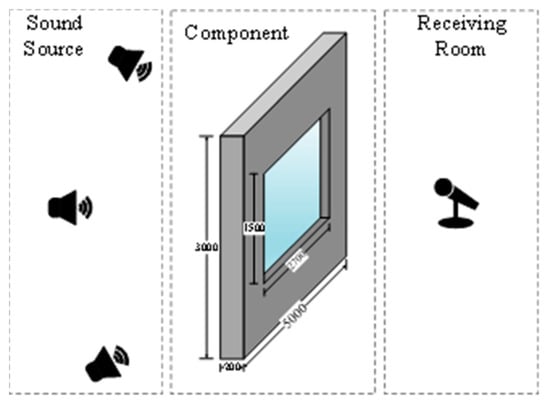
Figure 8.
Calculation model of individual component for sound insulation.
The upper limit frequency fmax in acoustic calculations is related to the grid size L as described by Equation (1) []:
where c denotes the speed of sound propagation in the medium—340 m/s for air.
According to Equation (1), the grid size of the model has been determined as 10 mm to obtain the maximum analysis frequency of 5000 Hz. The specific parameters for the single-layer glass window and concrete wall are presented in Table 2.

Table 2.
Model Parameters.
Utilizing the parameters presented in Table 2, a structural model and an acoustic grid were developed, with an acoustic envelope surface incorporated through acoustical preprocessing. The acoustic radiation boundary conditions were established by applying the AML attribute layer to the left and right sides of the acoustic surfaces, designating one side as anechoic chamber and the other as a reverberation chamber (see Figure 8). Following the configuration of the acoustic boundary conditions, structural boundary conditions were also defined. The lateral faces of the structural elements were designated as constrained element groups under simply supported constraints. The contact interfaces between the acoustic grid and structural grid were configured as coupling faces, with a tolerance for these coupling faces at 10 mm.
First, sound–structure coupling calculations were conducted on the individual window and wall element to obtain its sound insulation curves. These calculated curves were then compared against those obtained from lab tests in a reverberation-absorption chamber. Figure 9 and Figure 10 give comparative results for the calculated and experimental values of sound insulation performance for the single-layer glass window and concrete wall components, respectively.

Figure 9.
Comparison of crossover frequency sound insulation of single pane glass.
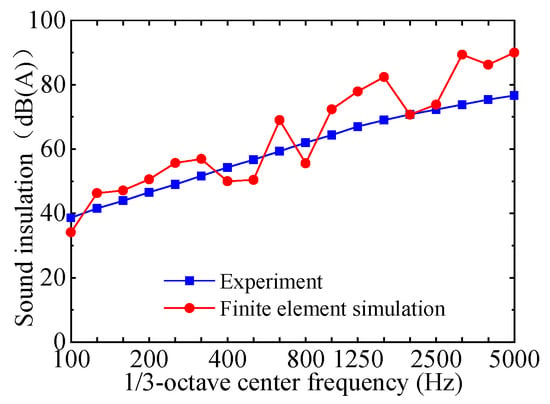
Figure 10.
Comparison of crossover frequency sound insulation of concrete.
As shown in Figure 9, for the single-layer glass window component, the trend of the calculated sound insulation curve aligns closely with the experimental ones. Specifically, the sound insulation calculation results at frequencies below 1600 Hz closely match with the experimental data, while discrepancies of approximately 10% are observed in the range of 2000 Hz to 5000 Hz. For the concrete wall component, although the trend in sound insulation calculations is consistent with the measured values, some frequency points display larger errors primarily attributable to the size effects. Overall, both types of components demonstrate commendable consistency between the calculated and measured sound insulation results. This demonstrated that the acoustic parameters employed in finite element analysis are reasonable and suitable for subsequent investigations into structural sound insulation for window-wall assembly components.
3.3. Sound Insulation Analysis Using the Window-Wall Assembly Model
Utilizing the window and wall dimensions of the test site, a finite element model of the window-wall assembly components was developed, with acoustic parameters configured in accordance with the results presented in Section 3.2. The finite element model is illustrated in Figure 11. The parameters for the model are presented in Table 3.

Figure 11.
Finite element model of window-wall assembly components.

Table 3.
Model Parameters of the window-wall assembly model.
In contrast to the modeling of individual components, the assembling of the wall and window results in a recessed wall surface due to discrepancies in thickness dimensions. Consequently, it is necessary for the air layer to be protruding to ensure the accuracy of sound–vibration coupling calculations.
To improve computational efficiency, two grid sizes for the air layer—20 mm and 10 mm—were employed. According to the relationship between analytical frequency and grid size (as described in Equation (1)), the 20 mm grid supports analysis frequencies up to 2500 Hz, while the 10 mm grid supports frequencies up to 5000 Hz. Therefore, a 20 mm grid is utilized for frequency ranges from 50 Hz to 2500 Hz, whereas a 10 mm grid is applied for frequencies ranging from 2500–5000 Hz.
The sound–vibration coupling simulations were conducted on the window-wall assembly model, with results compared against measured values as illustrated in Figure 12.
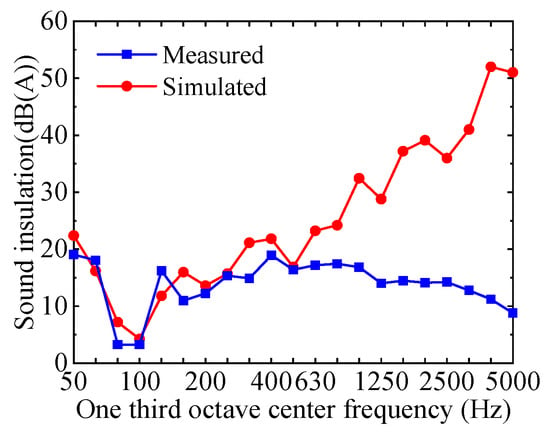
Figure 12.
Predicted sound insulation results using window-wall assembly model against measured ones.
As illustrated in Figure 12, the simulated results exhibit minimal error within the 50 Hz to 500 Hz frequency band, and the trend of the sound insulation curve aligns closely with the measured values. Conversely, in the 1000 Hz to 5000 Hz frequency band, simulated values are significantly higher than their measured counterparts; that is, the theoretical sound insulation performance is much better than the measured results. A potential explanation for this discrepancy is that instrument cables traversed through the window during testing, preventing a proper seal and resulting in sound leakage. The subsequent discussion will further explore how sound leakage affects sound insulation performance.
3.4. Sound Insulation Analysis Using the Window-Wall Assembly Model with Air Gaps
Considering the effect of sound leakage, the window gap was determined based on site conditions and positioned centrally with a width of 10 mm. The finite element model of the window-wall assembly component with an air gap is illustrated in Figure 13.
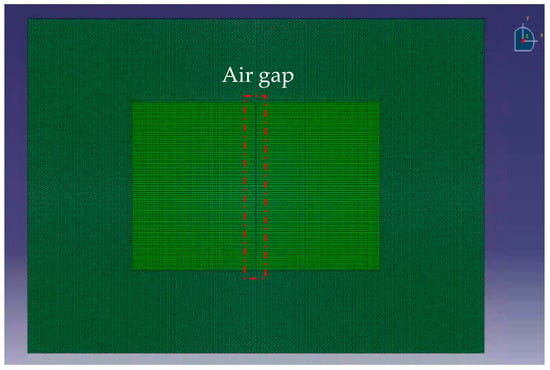
Figure 13.
Finite element model of the window-wall assembly component with air gap.
In terms of coupling surfaces, the window-wall assembly component with a gap exhibits a distinct configuration compared to its gapless counterpart. A 10 mm gap has been artificially introduced at the interface where it contacts the member’s gap.
Figure 14 shows a comparison between the calculated and measured sound insulation performance of the window-wall assembly model with a gap. Compared to the gapless condition, the sound insulation performance in the frequency band above 630 Hz decreases significantly, and it is more consistent with the measured results. The sound insulation valley in the frequency band of 80 Hz to 100 Hz disappears, and the overall trend of the curve becomes smoother. The overall calculated sound insulation performance is still greater than the measured value, mainly because the lateral sound transmission effect is ignored in the theoretical model.
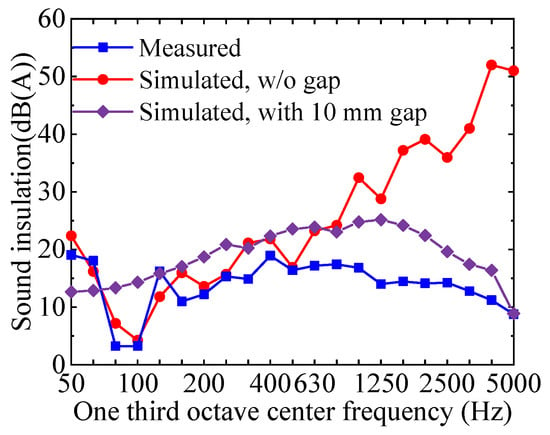
Figure 14.
Calculation results of sound insulation of window-wall assembly model with air gap.
To investigate the effect of gap width on the sound insulation performance, four additional gap sizes—20 mm, 30 mm, 40 mm, and 50 mm—were considered for comparative analysis, with the results presented in Figure 15 and Figure 16.

Figure 15.
Calculated results for different gap widths.
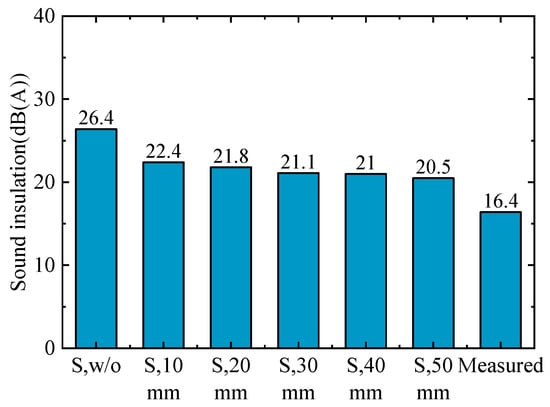
Figure 16.
Sound insulation with different air gap widths. Note: S,w/o, simulated w/o gap; S,10 mm, simulated with 10 mm gap; S,20 mm, simulated with 20 mm gap; S,30 mm, simulated with 30 mm gap; S,40 mm, simulated with 40 mm gap; S,50 mm, simulated with 50 mm gap.
The sound insulation amount generally decreases with the increase in gap width; however, the rate of change varies. The most pronounced reduction in sound insulation occurs when transitioning from no gap to a 10 mm gap, resulting in a decrease of 4 dB (A), whereas at a 50 mm gap, the reduction is approximately 6 dB (A). Notably, there is no obvious pattern regarding sound insulation across different gap widths. Furthermore, the calculated sound insulation values for various gap widths remain higher than the measured ones, probably due to the omission of lateral sound transmission effects in the theoretical model.
4. Discussion
Section 3 introduces the sound insulation calculation method for the window-wall assembly components and verifies the feasibility of obtaining building sound insulation characteristics by using a simplified window-wall assembly model. This section further discusses two main factors, namely windows and walls, on the sound insulation properties of buildings.
A benchmark window-wall assembly model, shown in Figure 17, features a wall measuring 3600 × 3600 × 240 mm and a window measuring 1500 × 1800 × 5 mm.
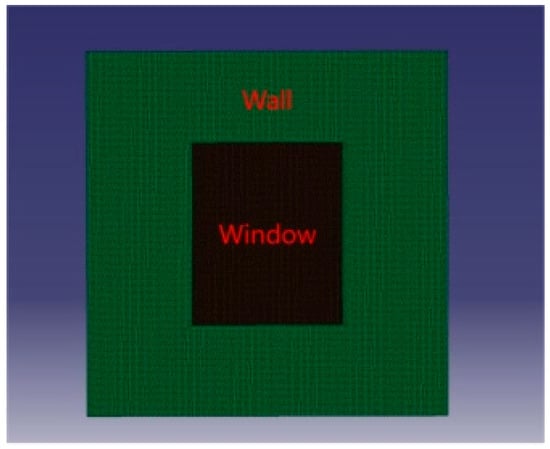
Figure 17.
Schematic diagram of the computational model.
4.1. Effect of Windows on Sound Insulation Capability
Four types of windows, including single-pane glass, double-pane glass, PVB laminated glass (with different thicknesses), and double-layer composite structure glass windows, are considered to assess the influence of window type on sound insulation performance. The walls are constructed using aerated concrete blocks. The geometrical parameters and material properties of these four types of glass windows are listed in Table 4.

Table 4.
Parameters for windows.
Sound insulation calculations were conducted for the aforementioned five cases, with the results presented in Figure 18.

Figure 18.
Sound insulation amounts for different window types. Note: SG, single-layer glass; DG, double-layer glass; 0.38 PVB, 0.38 PVB laminated glass; 0.76 PVB, 0.76 PVB laminated glass; DCSG, double-layer composite structure glass.
It is observed that the sound insulation amount of the window-wall assembly component is approximately 26 dB for the single-layer glass window. It improves by about 1.5 dB to 2 dB for the double-layer insulated glass window. The sound insulation property of the PVB laminated glass window surpasses that of the double-layer insulated glass window; specifically, the sound insulation of the 0.38PVB laminated glass window increases by approximately 6 dB, while that of the 0.76PVB laminated glass window rises by around 8.5 dB. Notably, the double-layer composite structure glass window exhibits the highest sound insulation improvement of 13 dB.
The sound insulation curves in the frequency domain of all the considered types of windows show a consistent trend across various conditions in the mid-frequency range (200 Hz to 3150 Hz), with all cases exhibiting a trough in sound insulation at 3150 Hz followed by an upward trend beyond this frequency. Compared to the single-layer glass window, the other three types of windows increase the overall sound insulation capability across all frequency points, particularly against low-frequency noise interference. Furthermore, employing an air layer alongside PVB lamination significantly improves acoustic isolation capabilities, most notably at a low-frequency attenuation near 100 Hz within single-layer configurations where a trough exists in sound transmission loss data. The double-layer composite structure window has the best sound insulation capability, followed in descending order by the PVB laminated window and the double-layer insulated glass window, and the single-layer glass window gives the poorest sound insulation capability.
4.2. Effect of Wall on Sound Insulation Capability
Five wall thicknesses—100 mm, 150 mm, 200 mm, 250 mm, and 300 mm, are considered to assess the influence of wall thickness on sound insulation performance. These specific thicknesses are based on common construction practices in engineering applications. A single-pane glass window is adopted for the analysis.
Four types of wall materials are considered, including common concrete, brick walls, lightweight concrete, and foam concrete. They are all common construction materials of walls widely employed in application. The parameters of the different walls are given in Table 5.

Table 5.
Parameters for different walls.
Figure 19a–d illustrates the simulation results of sound insulation under different wall materials with various wall thicknesses.
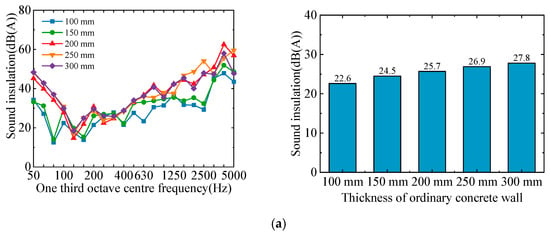
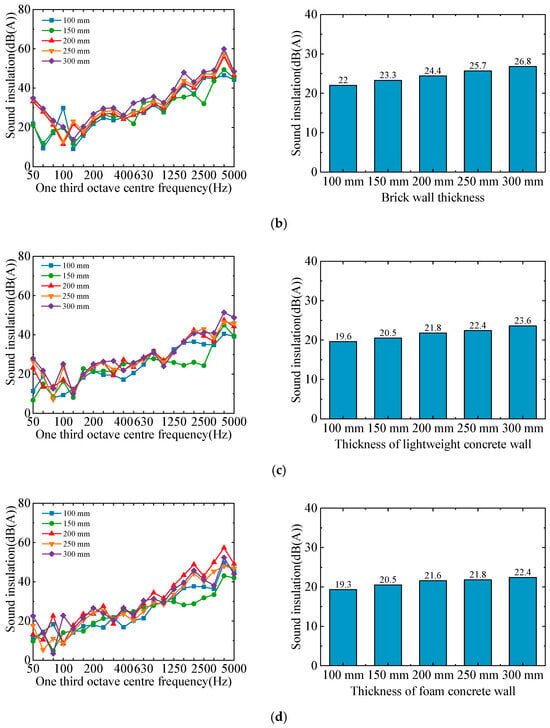
Figure 19.
Sound insulation capability for different wall materials and thicknesses: (a) common concrete walls; (b) brick walls; (c) lightweight concrete walls; (d) foam concrete walls.
The results presented in Figure 19a–d are further fitted in plots, as shown in Figure 20, and the sound insulation capability R (unit in dB) of the four types of wall materials could be represented in terms of wall thickness t (unit in mm), as expressed in Equation (2).
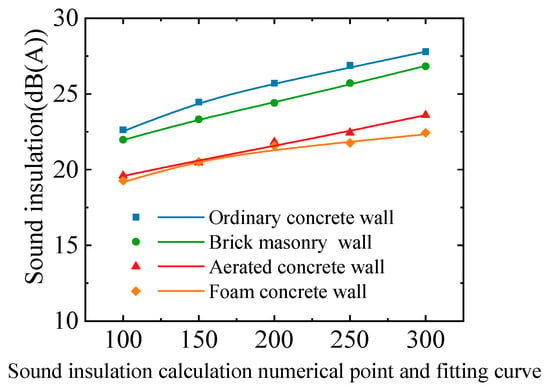
Figure 20.
Relationship between sound insulation and wall thickness.
The sound insulation analysis in the frequency domain indicates that an increase in mass density and elastic modulus can significantly improve the low-frequency sound insulation performance of building components. Specifically, for varying wall thicknesses, it has been observed that the sound insulation valley for components with thicknesses of 100 mm and 150 mm occurs at frequencies below 100 Hz. In contrast, thicker components with 200 mm, 250 mm, and 300 mm thickness exhibit sound insulation valleys at approximately 125 Hz.
In terms of high-frequency performance, all four types of wall material components demonstrate notable sound insulation peaks around frequencies of 2500 Hz and 3150 Hz. These phenomena are closely linked to both the physical dimensions and modal characteristics inherent to each component’s design. Furthermore, within the mid-frequency band (ranging from 800 Hz to 2500 Hz), it is evident that both the 100 mm- and 150 mm-thick components display significantly lower levels of sound insulation compared to their thicker counterparts—specifically those measuring either 200 mm or greater.
The analysis of the overall sound insulation values reveals that, when the thickness of the component is increased from 100 mm to 150 mm, the sound insulation value increases by approximately 1 to 2 dB; an increase from 150 mm to 200 mm results in a gain of about 1 to 1.5 dB; transitioning from 200 mm to 250 mm yields an increase of roughly 0.5 to 1 dB; and finally, increasing the thickness from 250 mm to 300 mm leads to an enhancement of about 0.7 to 1.1 dB. Notably, when the component’s thickness is doubled from 100 mm to 200 mm, one would expect a corresponding increase in sound insulation value between approximately 2 and 4 dB across various materials.
Furthermore, reductions in the mass density and elastic modulus of wall materials contribute significantly to decreases in their sound insulation capabilities. For instance, brick walls exhibit lower sound insulation performance compared with ordinary concrete walls, decreasing by approximately 0.6 to 1.3 dB; lightweight concrete walls show a reduction of about 3 dB compared with ordinary concrete walls; while foam concrete walls demonstrate a decrease ranging between 3 and 4 dB compared with ordinary concrete walls.
Compared with the acoustic insulation capabilities of individual components, it is observed that windows are the most significant component that dominates the sound insulation capability of the window-wall assembly components.
4.3. Limitations of the Current Work
This study tries to provide a simple but efficient tool to take into account the sound insulation characteristics of buildings along elevated urban rail lines. A window-wall assembly model has been proposed based on several assumptions. Since the lateral sound transmission loss from adjacent walls is ignored, the model may give higher sound insulation values compared to the measured ones. The presence of an air gap was found to have an impact on the sound insulation performance of buildings. In this current study, a window-wall assembly model with an air gap was employed to consider its effect. The model can generally reveal the sound insulation characteristics of buildings.
Additionally, for high-rise buildings, the measured outdoor sound source at different floors varies along the height of building during train operation due to sound propagation. Since only limited test points were installed, the effect of the building’s height on sound insulation characteristics is not considered.
This study may serve as the first step toward a better understanding of the sound insulation characteristics of buildings. More effort will be made in the future to explore more efficient tools to quantify this effect.
5. Conclusions
Based on the above analyses, the following conclusions could be drawn:
The measured overall sound insulation of buildings situated along the elevated urban rail transit lines was found to range from 11.16 dB (A) to 19.85 dB (A). The sound insulation curve showed a sound insulation valley at 80 Hz to 100 Hz, an upward trend from 100 Hz to 800 Hz, and a downward trend from 1000 Hz to 5000 Hz. The established window-wall assembly model can effectively reveal the sound insulation characteristics of the test building. The air gap in windows should be taken into account in the sound insulation analysis since it has a notable impact on the high-frequency sound insulation capability. Windows are the most significant component that dominates the sound insulation capability of the window-wall assembly components.
In this paper, a window-wall assembly model was proposed for simulating building sound insulation by neglecting the influence of lateral sound transmission from adjacent walls, resulting in a slightly higher calculated sound insulation value than the measured one. This issue will be taken into account in future studies. In addition, sound insulation analysis for different wall types and window types is also a worthwhile research topic. The research findings can provide a reference for noise control in buildings along the elevated urban rail transit system.
Author Contributions
Conceptualization, methodology, writing—original draft preparation, W.H.; formal analysis, investigation, writing—review and editing, T.W.; validation, writing—review and editing, D.W. and J.C. All authors have read and agreed to the published version of the manuscript.
Funding
This research was funded by the project of the Ministry of Housing and Urban-Rural Development of the People’s Republic of China (grant number 2022-K-153).
Data Availability Statement
The original contributions presented in the study are included in the article, further inquiries can be directed to the corresponding author.
Conflicts of Interest
Authors Teng Wang, Dongyang Wang and Jialiang Chen were employed by the companies Beijing Oriental Yuhong Waterproof Technology Co., Ltd. and Beiijao Zane Rail Technology (Beijing) Co., Ltd. The remaining authors declare that the research was conducted in the absence of any commercial or financial relationships that could be construed as a potential conflict of interest.
References
- Zhou, L.; Yu, Q.; Zeng, X. Analysis of current situation of urban rail transit noise and related countermeasures. China Environ. Prot. Ind. 2023, 4, 53–59. (In Chinese) [Google Scholar]
- Welch, D.; Shepherd, D.; Dirks, K.N.; Reddy, R. Health effects of transport noise. Transp. Rev. 2023, 43, 1190–1210. [Google Scholar] [CrossRef]
- Tetiranont, S.; Sadakorn, W.; Rugkhapan, N.; Prasittisopin, L. Enhancing Sustainable Railway Station Design in Tropical Climates: Insights from Thailand’s Architectural Theses and Case Studies. Buildings 2024, 14, 829. [Google Scholar] [CrossRef]
- Gangwar, M.; Sharma, S.M. Evaluating choice of traction option for a sustainable Indian Railways. Transp. Res. Part D Transp. Environ. 2014, 33, 135–145. [Google Scholar] [CrossRef]
- He, W.; He, K.; Zou, C.; Yu, Y. Experimental noise and vibration characteristics of elevated urban rail transit considering the effect of track structures and noise barriers. Environ. Sci. Pollut. Res. 2021, 28, 45903–45919. [Google Scholar] [CrossRef] [PubMed]
- Qiu, Y.; Zou, C.; Hu, J.; Chen, J. Prediction and mitigation of building vibrations caused by train operations on concrete floors. Appl. Acoust. 2024, 219, 109941. [Google Scholar] [CrossRef]
- He, W.; Liu, J.; Song, S.; Liu, P. A non-contact vehicle weighing approach based on bridge weigh-in-motion framework and computer vision techniques. Measurement 2024, 225, 113994. [Google Scholar] [CrossRef]
- Zou, C.; Li, X.; He, C.; Zhou, S. An efficient method for estimating building dynamic response due to train operations in tunnel considering transmission path from source to receiver. Comput. Struct. 2024, 305, 107555. [Google Scholar] [CrossRef]
- Hu, J.; Zou, C.; Liu, Q.; Li, X.; Tao, Z. Floor vibration predictions based on train-track-building coupling model. J. Build. Eng. 2024, 89, 109340. [Google Scholar] [CrossRef]
- Yu, L.; Bu, Z.; Li, L.; Zhu, X.; Lei, Z.; Luo, Y. Characteristics analysis of urban rail viaduct structure noise considering Doppler effect. Urban Mass Transit 2020, 23, 74–79+85. (In Chinese) [Google Scholar]
- He, W.; Zou, C.; Pang, Y.; Wang, X. Environmental noise and vibration characteristics of rubber-spring floating slab track. Environ. Sci. Pollut. Res. 2021, 28, 13671–13689. [Google Scholar] [CrossRef]
- Zhao, Y.; Li, X.; Lv, Q.; Jiao, H.; Xiao, X.; Jin, X. Measuring, modelling and optimising an embedded rail track. Appl. Acoust. 2017, 116, 70–81. [Google Scholar] [CrossRef]
- Li, X.; Chen, Y.; Zou, C.; Chen, Y. Train-induced vibration mitigation based on foundation improvement. J. Build. Eng. 2023, 76, 107106. [Google Scholar] [CrossRef]
- He, W.; He, K.; Yao, C.; Liu, P.; Zou, C. Comparison of damping performance of an aluminum bridge via material damping, support damping and external damping methods. Structures 2022, 45, 1139–1155. [Google Scholar] [CrossRef]
- Li, X.; Liang, L.; Zhao, Q. Influence of track structure type on noise radiated from an elevated box-girder. China Civ. Eng. J. 2018, 51, 78–87. (In Chinese) [Google Scholar]
- Song, L.; Li, X.; Zhang, L.; Liu, Q.; Feng, Q.; Luo, Y. Characteristics and prediction of structure-borne noise from urban rail transit bridge-sound barrier system. J. Traffic Transp. Eng. 2021, 21, 193–202. (In Chinese) [Google Scholar]
- Song, L.; Gao, K.; Liu, Q.; Liu, L.; Feng, Q. Study on the structure-borne noise of U-shaped girder bridges with fully-enclosed sound barriers. Appl. Acoust. 2023, 211, 109497. [Google Scholar] [CrossRef]
- Frid, A. Skirts and barriers for reduction of wayside noise from railway vehicles—An experimental investigation with application to the BR185 locomotive. J. Sound Vib. 2003, 267, 709–719. [Google Scholar] [CrossRef]
- Granzotto, N.; Bettarello, F.; Ferluga, A.; Marsich, L.; Schmid, C.; Fausti, P.; Caniato, M. Energy and acoustic performances of windows and their correlation. Energy Build. 2017, 136, 189–198. [Google Scholar] [CrossRef]
- Wu, W.; He, W.; Yu, H. Study and analysis on sound insulation performance of several common kinds of light weight panel for building partition. Sichuan Build. Sci. 2021, 47, 83–89. (In Chinese) [Google Scholar]
- Zhu, X.; Wang, L.; Wang, X.; Jiang, J. Simulation Study of Sound Insulation Performance of the Double-glazed Window. Noise Vib. Control. 2022, 42, 256–262. (In Chinese) [Google Scholar]
- Liu, M.; Peng, L.; Fan, Z.; Wang, D. Sound Insulation and Mechanical Properties of wood damping composites. Wood Res. 2019, 64, 743–758. [Google Scholar]
- Wang, J.; Du, B. Experiment on the optimization of sound insulation performance of residential floor structure. Appl. Acoust. 2021, 174, 107734. [Google Scholar] [CrossRef]
- Liu, X. Acoustic Analysis of Windows and Walls Using LMS Virtual.Lab. Master’s Thesis, Nanchang Hangkong University, Nanchang, China, 2016. (In Chinese). [Google Scholar]
- Lakshmikandhan, K.N.; Harshavardhan, B.S.; Prabakar, J.; Saibabu, S. Investigation on Wall Panel Sandwiched with Lightweight Concrete. IOP Conf. Ser. Mater. Sci. Eng. 2017, 225, 012275. [Google Scholar] [CrossRef]
- Arjunan, A.; Baroutaji, A.; Robinson, J.; Vance, A.; Arafat, A. Acoustic metamaterials for sound absorption and insulation in buildings. Build. Environ. 2024, 251, 111250. [Google Scholar] [CrossRef]
- Osipov, A.; Mees, P.; Vermeir, G. Numerical simulation of airborne sound transmission at low frequencies: The influence of the room and the partition parameters. Proc. Inter-Noise 1997, 2, 759–762. [Google Scholar]
- Maluski, S.P.S.; Gibbs, B.M. Application of a finite-element to low-frequency sound insulation in dwellings. Acoust. Soc. Am. 2000, 108, 1741–1751. [Google Scholar] [CrossRef] [PubMed]
- Ljunggren, L. Airborne sound insulation of single walls at low frequencies: A discussion on the influence of boundary and mounting conditions. Build. Acoust. 2001, 8, 257–267. [Google Scholar] [CrossRef]
- Tadeu, A.; António, J. Acoustic insulation of single panel walls provided by analytical expressions versus the mass law. Sound Vib. 2002, 257, 457–475. [Google Scholar] [CrossRef]
- GB/T 19889.5-2006; Acoustics—Measurement of Sound Insulation in Building Elements Part 5: Field Measurements of Airborne Sound Insulation of Façade Elements and Facades. China Architecture & Building Press: Beijing, China, 2006.
- GB/T 19889.3-2005; Acoustics—Measurement of Sound Insulation in Buildings and of Building Elements Part 3: Laboratory Measurements of Airborne Sound Insulation of Building Elements. China Architecture & Building Press: Beijing, China, 2006.
- Ferziger, J.H.; Peric, M. Computational Methods for Fluid Dynamics; Springer: Berlin/Heidelberg, Germany, 2002. [Google Scholar]
Disclaimer/Publisher’s Note: The statements, opinions and data contained in all publications are solely those of the individual author(s) and contributor(s) and not of MDPI and/or the editor(s). MDPI and/or the editor(s) disclaim responsibility for any injury to people or property resulting from any ideas, methods, instructions or products referred to in the content. |
© 2024 by the authors. Licensee MDPI, Basel, Switzerland. This article is an open access article distributed under the terms and conditions of the Creative Commons Attribution (CC BY) license (https://creativecommons.org/licenses/by/4.0/).